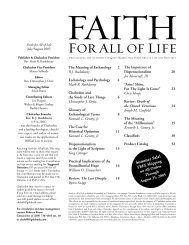Chalcedon Report No. 5..........................................................
Chalcedon Report No. 5..........................................................
Chalcedon Report No. 5..........................................................
You also want an ePaper? Increase the reach of your titles
YUMPU automatically turns print PDFs into web optimized ePapers that Google loves.
Celebrating the<br />
history of the<br />
<strong>Chalcedon</strong> Foundation<br />
and the work of R. J.<br />
Rushdoony (“Rush”) is<br />
a difficult thing to do.<br />
Rush would frown on any attempts to<br />
cover or acknowledge the history of an<br />
institution — he was about ideas not organizations.<br />
Because of this, the history<br />
and people involved are scattered and<br />
diffused. In terms of the organization<br />
there is no clear line of growth. The only<br />
measurable growth is the ever-increasing<br />
influence of the message. That’s what<br />
Rush was working towards.<br />
But it is practical to share a particular<br />
angle of the story of <strong>Chalcedon</strong>, especially<br />
for those who are unfamiliar with<br />
the history of Christian Reconstruction. 1<br />
Typically, most historical accounts<br />
begin with the date and location of the<br />
birth of the founder. When discussing<br />
Christian Reconstruction this is not<br />
Rushdoony in younger years sporting an indian headress<br />
6 Faith for All of Life September/October 2005<br />
Faith for All of Life<br />
The Story of an Idea<br />
By Christopher J. Ortiz<br />
what’s important. Rushdoony would<br />
consider it irrelevant. The proper starting<br />
point is the birth of the ideas.<br />
Theonomy or Autonomy<br />
He was a long way from his last<br />
home in Santa Cruz, California, in<br />
1946 when the thirty-year-old Rousas<br />
experienced the great transformation<br />
to his thinking. Isolated within the 400<br />
square miles of the Duck Valley Indian<br />
Reservation in Owyhee, Nevada, this<br />
contemplative missionary-pastor had<br />
already spent a year and a half carving<br />
out the Kingdom of God among the<br />
Western Shoshone Indians.<br />
Rousas was of medium height with<br />
dark hair, olive skin, and a silent look<br />
that left one wondering what was transpiring<br />
behind his deep eyes and pronounced<br />
brow. He sparked the curiosity<br />
of the Duck Valley residents. Like most<br />
Native Americans, their culture was not<br />
noted for its scholarship. Life was basic,<br />
with time spent on bare necessities,<br />
not penetrating the lofty ideas found<br />
in books. Theirs was an oral tradition<br />
animated by story and legend. Rousas,<br />
on the other hand, was a man of written<br />
words and rigorous thinking. In this<br />
environment the studious young missionary<br />
was as out of place as a Cadillac<br />
on the Moon.<br />
He didn’t seem to need many supplies<br />
on the reservation — only books.<br />
The Shoshones would watch with<br />
interest as Rousas frequently received<br />
a delivery of books to his mailbox. He<br />
seemed oblivious to his onlookers as<br />
he tore open each package and began<br />
reading as he walked back to his home<br />
— never lifting his head.<br />
Rushdoony received numerous<br />
books during his stint on the reservation,<br />
but one volume in particular<br />
affected him deeply. The New Modernism<br />
by Dr. Cornelius Van Til was a new<br />
release in 1946 and promised An Appraisal<br />
of the Theology of Barth and Brunner<br />
— something the young Rousas was<br />
much interested in due to the widening<br />
influence of modernism in Protestant<br />
circles. Dr. Van Til was a sober but humorous<br />
Dutchman whose slender frame<br />
and thick glasses disguised his long<br />
history as a trenchant defender of the<br />
Christian faith. He was the professor of<br />
apologetics at Westminster Theological<br />
Seminary and from that single location<br />
launched a sustained campaign against<br />
humanism, modernity, and their Christian<br />
cousin, neo-orthodoxy.<br />
Despite the theological strength of<br />
such establishments as Westminster,<br />
modernism continued its determined<br />
march into the Second World War.<br />
Its influence was felt in many spheres




